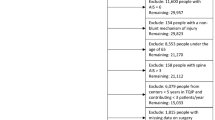Abstract
Background
Type II odontoid fractures are reportedly increasing in incidence and occur primarily in the elderly. Neurologic deficits (ND) at presentation add to the morbidity of these fractures; however, reports are limited as a result of small case series. It is unclear what specific complications are associated with ND and whether these result in increased incidence of mortality.
Questions/purposes
We established the incidence of ND with Type II odontoid fractures and determined if ND are associated with increased inpatient mortality and morbidity during hospitalization.
Methods
Twenty patients with acute Type II odontoid fracture and ND were identified from our institutional database. Baseline presenting characteristics and hospital course data were collected. The cohort was compared with a previously published cohort of 188 patients without ND by age, mechanism of injury, displacement, associated spinal injuries, comorbidities, treatment, mortality, and complications. Patients were only followed during acute-care hospitalization (mean, 11.9 days; range, 0–41 days).
Results
The incidence of ND among all Type II odontoid fractures was 9.6%. Ten of 20 patients with Type II odontoid fractures and ND died during hospitalization, and patients with complete cord injuries were 9.33 (95% confidence interval, 1.19–73.0) times more likely to die. Patients with ND experienced more complications and more respiratory complications than those without ND.
Conclusions
ND after Type II odontoid fractures is a rare event associated with a high risk of early and rapid clinical decline.
Level of Evidence
Level III, prognostic study. See Guidelines for Authors for a complete description of levels of evidence.
Similar content being viewed by others
References
Anderson LD, D’Alonzo RT. Fractures of the odontoid process of the axis. J Bone Joint Surg Am. 1974;56:1663–1674.
Crockard HA, Heilman AE, Stevens JM. Progressive myelopathy secondary to odontoid fractures: clinical, radiological, and surgical features. J Neurosurg. 1993;78:579–586.
Dickman CA, Hadeley MN, Browner C, Sonntag VKH. Neurosurgical management of acute atlas-axis combination fractures. J Neurosurg. 1989;70:45–49.
Ditunno JF Jr, Young W, Donovan WH, Creasey G. The international standards booklet for neurological and functional classification of spinal cord injury. Paraplegia. 1994;32:70–80.
Fassett DR, Harrop JS, Maltenfort M, Jeyamohan SB, Ratliff JD, Anderson DG, Hilibrand AS, Albert TJ, Vaccaro AR, Sharan AD. Mortality rates in geriatric patients with spinal cord injuries. J Neurosurg Spine. 2007;7:277–281.
Harris MB, Reichmann WM, Bono CM, Bouchard K, Corbett KL, Warholic N, Simon JB, Schoenfeld AJ, Maciolek L, Corsello P, Losina E, Katz JN. Mortality in elderly patients after cervical spine fractures. J Bone Joint Surg Am. 2010;92:567–574.
Harrop JS, Sharan AD, Przybylski GJ. Epidemiology of spinal cord injury after acute odontoid fractures. Neurosurg Focus. 2000;8:e4.
Harrop JS, Sharan AD, Scheid EH, Vaccaro AR, Przybylski GJ. Tracheostomy placement in patients with complete cervical spinal cord injuries: American Spinal Injury Association Grade A. J Neurosurg. 2004;100(Suppl):20–23.
Harrop JS, Vaccaro A, Przybylski GJ. Acute respiratory compromise associated with flexed cervical traction after C2 fractures. Spine. 2001;26:E50–E54.
Kirankumar MV, Behari S, Salunke P, Banerji D, Chhabra DK, Jain VK. Surgical management of remote, isolated Type II odontoid fractures with atlantoaxial dislocation causing cervical compressive myelopathy. Neurosurgery. 2005;56:1004–1012; discussion 1004–1012.
Koech F, Ackland HM, Varma DK, Williamson OD, Malham GM. Nonoperative management of Type II odontoid fractures in the elderly. Spine. 2008;33:2881–2886.
Krassioukov A. Autonomic function following cervical spinal cord injury. Respir Physiol Neurobiol. 2009;169:157–164.
Lasfargues JE, Custis D, Morrone F, Carswell J, Nguyen T. A model for estimating spinal cord injury prevalence in the United States. Paraplegia. 1995;33:62.
Malik SA, Murphy M, Connolly P, O’Byrne J. Evaluation of morbidity, mortality and outcome following cervical spine injuries in elderly patients. Eur Spine J. 2008;17:585–591.
Müller EJ, Wick M, Russe O, Muhr G. Management of odontoid fractures in the elderly. Eur Spine J. 1999;8:360–365.
Pepin JW, Bourne RB, Hawkins RJ. Odontoid fractures, with special reference to the elderly patient. Clin Orthop Relat Res. 1985;193:178–183.
Ryan MD, Taylor TK. Odontoid fractures. A rational approach to treatment. J Bone Joint Surg Br. 1982;64:416–421.
Ryan MD, Taylor TK. Odontoid fractures in the elderly. J Spinal Disord. 1993;6:397–401.
Smith HE, Fehlings M, Chapman J, Maltenfort M, Zaslavasky J, Kerr S, Harris E, Albert T, Harrop J, Hilibrand A, Anderson DG, Vaccaro AR. Trends in epidemiology and management of Type II odontoid fractures: 20 year experience at a model system spine injury tertiary referral center. J Spinal Disord Tech. 2010;23:501–505.
Smith HE, Kerr SM, Maltenfort M, Chaudhry S, Norton R, Albert TJ, Harrop J, Hilibrand AS, Anderson DG, Kopjar B, Brodke DS, Wang JC, Fehlings MG, Chapman JR, Patel A, Arnold PM, Vaccaro AR. Early complications of surgical versus conservative treatment of isolated Type II odontoid fractures in octogenarians: a retrospective cohort study. J Spinal Disord Tech. 2008;21:535–539.
Smith HE, Vaccaro AR, Maltenfort M, Albert TJ, Hilibrand AS, Anderson DG, Harrop J, Fehlings MG, Kopjar B, Brodke DS, Arnold PM, Shaffrey CI. Trends in surgical management for Type II odontoid fracture: 20 years of experience at a regional spinal cord injury center. Orthopedics. 2008;31:650.
Varma A, Hill EG, Nicholas J, Selassie A. Predictors of early mortality after traumatic spinal cord injury: a population-based study. Spine. 2010;35:778–783.
Acknowledgments
We thank Martin E. Griffis, BA, from Temple University for his assistance in data collection and Mitchell Maltenfort, PhD, from the Department of Neurosurgery at Thomas Jefferson University Hospital for his assistance in statistical analysis for this study.
Author information
Authors and Affiliations
Corresponding author
Additional information
Each author certifies that he or she has no commercial associations (eg, consultancies, stock ownership, equity interest, patent/licensing arrangements, etc) that might pose a conflict of interest in connection with the submitted article.
Each author certifies that his or her institution has approved the human protocol for this investigation and that all investigations were conducted in conformity with ethical principles of research.
This work was performed at the Rothman Institute, Thomas Jefferson University Hospital, Philadelphia, PA, USA.
About this article
Cite this article
Patel, A., Smith, H.E., Radcliff, K. et al. Odontoid Fractures With Neurologic Deficit Have Higher Mortality and Morbidity. Clin Orthop Relat Res 470, 1614–1620 (2012). https://doi.org/10.1007/s11999-011-1994-8
Published:
Issue Date:
DOI: https://doi.org/10.1007/s11999-011-1994-8




